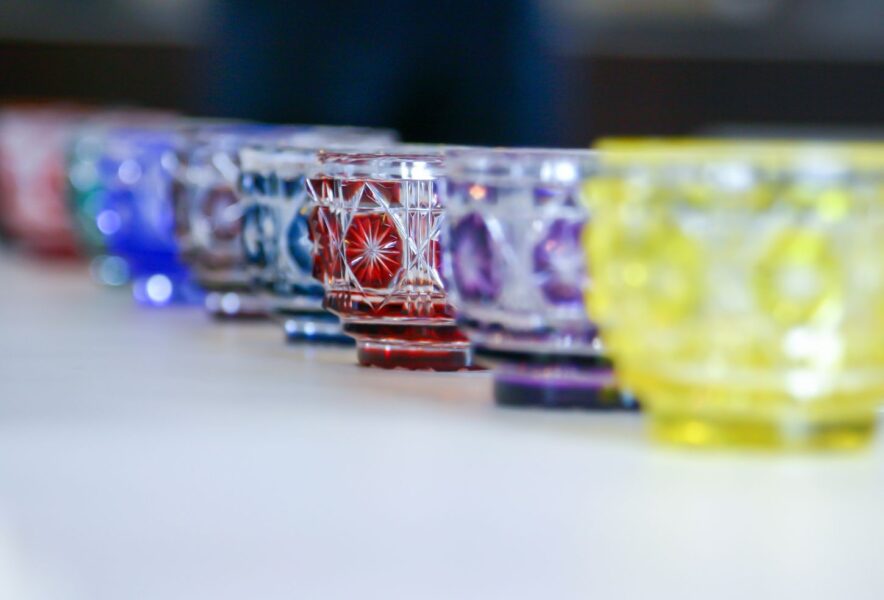Edo Kiriko is Japan’s traditional cut glassware, known for its intricate designs and brilliant craftsmanship. Featuring beautifully etched patterns, Edo Kiriko glass sparkles as it catches the light, enhancing both its functional and decorative value. This blog will explore the history, craftsmanship, and styles of Edo Kiriko, as well as where to buy authentic pieces in Tokyo.
What is Edo Kiriko? An Introduction to Japan’s Traditional Cut Glassware
Edo Kiriko is a traditional form of Japanese glassware distinguished by its detailed, hand-cut designs. The craft involves cutting geometric patterns into clear or colored glass, creating dazzling visual effects when light passes through. Edo Kiriko is admired for its precision and artistry, and each piece is made with a level of care that reflects Japan’s long-standing dedication to craftsmanship.
The History of Edo Kiriko: From the Edo Period to Today
The origins of Edo Kiriko date back to the Tenpo Era of the Edo period (1830s). Glass artisans in Edo (now Tokyo) began using cutting techniques introduced from Europe to create decorative glassware. Over time, Edo Kiriko evolved into a uniquely Japanese craft, incorporating traditional patterns and designs.
During the Meiji period (1868–1912), advancements in technology allowed for even greater precision in glass cutting, and Edo Kiriko became increasingly popular. Today, it is regarded as a symbol of Japanese heritage and is cherished both as fine glassware and as a beautiful souvenir for tourists.
The Craftsmanship Behind Edo Kiriko: How It’s Made
Creating Edo Kiriko is an intricate process that requires exceptional skill and attention to detail. Artisans first blow or mold the glass into the desired shape, after which they use cutting wheels to carve out the decorative patterns. The depth and angle of each cut are carefully controlled, producing patterns that reflect and refract light in stunning ways. The process is entirely done by hand, making each piece of Edo Kiriko unique.
The precision required to make Edo Kiriko, from selecting the glass to creating the final cut patterns, demonstrates the level of craftsmanship that goes into each item. The result is glassware that not only serves a practical purpose but also stands as a work of art.
Types and Designs of Edo Kiriko: Patterns and Colors
Edo Kiriko comes in a variety of designs and colors, each with its own unique charm and significance. Some of the most common patterns include:
- Kagome (Basket Weave): A geometric pattern inspired by bamboo baskets, symbolizing stability and harmony.
- Nanako (Fish Eggs): A delicate design featuring small, repeated dots, representing abundance and delicacy.
- Shippo (Seven Treasures): Interlocking circles that represent eternity and the interconnectedness of life.
Edo Kiriko glass is often made using vibrant red or blue glass overlaid on clear glass, creating a beautiful contrast that enhances the visual appeal of the cut patterns. This combination of color and design results in a glassware piece that shines brightly when exposed to light.
Where to Buy Authentic Edo Kiriko in Tokyo
Tokyo is the best place to find authentic Edo Kiriko, with several areas offering stunning glassware made by skilled artisans. Here are some of the top spots to purchase Edo Kiriko:
- Asakusa: A popular tourist area where you’ll find shops selling Edo Kiriko, perfect for gifts or souvenirs.
- Ueno: Known for its cultural attractions, Ueno also offers a variety of traditional Japanese crafts, including Edo Kiriko.
- High-end Department Stores: Tokyo’s major department stores, especially in areas like Ginza, feature luxury Edo Kiriko items, often handmade by master artisans.
- Edo Kiriko Museum (Edo Kiriko Kan): Located in Tokyo’s Koto Ward, this museum not only showcases Edo Kiriko but also offers a range of glassware for sale. Visitors can also watch demonstrations and learn more about the craft’s history.
Whether you are looking for a decorative piece to display in your home or a functional item like a glass or bowl, Tokyo offers a wide selection of Edo Kiriko that beautifully captures the artistry and tradition of Japanese craftsmanship.

Comment